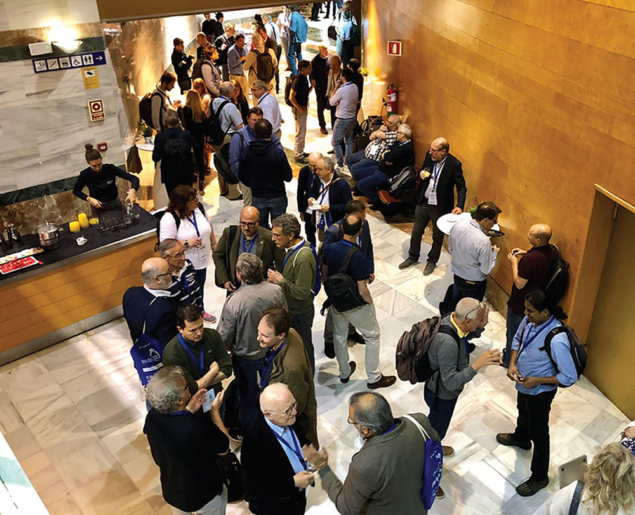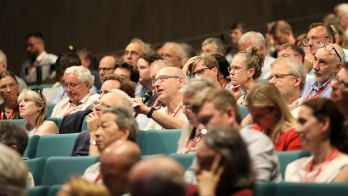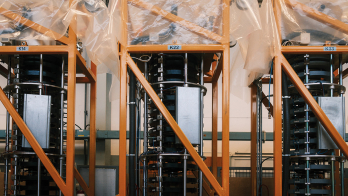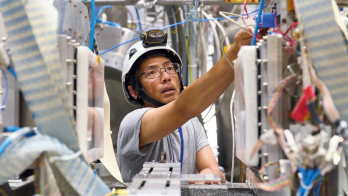
The open symposium of the European Strategy for Particle Physics (ESPP), which took place in Granada, Spain, from 13–16 May, revealed a vibrant field in flux as it grapples with how to attack the next big questions. Opening the event, chair of the ESPP strategy secretariat, Halina Abramowicz, remarked: “This is a very strange symposium. Normally we discuss results at conferences, but here we are discussing future results.” More than 10 different future-collider modes were under discussion, and the 130 or so talks and discussion sessions showed that elementary particle physics – in the wake of the discovery of the Higgs boson but so far no evidence of particles beyond the Standard Model (SM) – is transitioning into a new and less well-mapped realm of fundamental exploration.
Plain weird
Theorist Pilar Hernández of the University of Valencia described the SM as plain “weird”. The model’s success in describing elementary particles and their interactions is beyond doubt, but as an all-encompassing theory of nature it falls short. Why are the fermions arranged into three neat families? Why do neutrinos have an almost imperceptibly small mass? Why does the discovered Higgs boson fit the simplest “toy model” of itself? And what lies beneath the SM’s numerous free parameters? Similar puzzles persist about the universe at large: the mechanism of inflation; the matter–antimatter asymmetry; and the nature of dark energy and dark matter.
While initial results from the LHC severely constrain the most natural parameter spaces for new physics, said Hernández, the 10–100 TeV region is an interesting scale to explore. At the same time, she argued, there is a shift to more “bottom-up, rather than top-down”, approaches to beyond-SM (BSM) physics. The new quarries includes axion-like and long-lived particles, and searches for hidden, dark and feebly-interacting sectors – in addition to studying the Higgs boson, which has deep connections to many puzzles in the SM, with much greater precision. “Particle physics could be heading to crisis or revolution,” said Hernández.
Normally we discuss results at conferences, but here we are discussing future results
The accelerator, detector and computing technology needed for future fundamental exploration are varied and challenging. Reviewing Higgs-factory programmes, Vladimir Shiltsev, head of Fermilab’s Accelerator Physics Center, weighed up the pros and cons of linear versus circular machines. The former includes the International Linear Collider (ILC) and the Compact Linear Collider (CLIC); the latter a future circular electron–positron collider at CERN (FCCee) and the Circular Electron Positron Collider in China (CEPC). Linear colliders, said Shiltsev, are based on mature designs and organisation, are expandable to higher energies, and draw a wall-plug power similar to that of the LHC. On the other hand, they face challenges including their luminosity and number of interaction points. Circular Higgs factories offer a higher luminosity and more interaction points than linear options but require R&D into high-efficiency RF sources and superconducting cavities, said Shiltsev.
For hadron colliders, the three current options – CERN’s FCC-hh (100 TeV), China’s SppC (75 TeV) and a high-energy LHC (27 TeV) – demand next-generation superconducting dipole magnets. Akira Yamamoto of CERN/KEK said that while a lepton collider could begin construction in the next few years, the dipoles necessary for a hadron collider might take 10 to 15 years of R&D before construction could start.
The symposium also saw much discussion about muon colliders, which offer an energy-frontier lepton collider but for which it was widely acknowledged the technology is not yet ready. Concerning more futuristic acceleration technologies based on plasma wakefields, impressive results at facilities such as BELLA at Berkeley and AWAKE at CERN were on show.
Thinking ahead
From colliders to fixed-target to astrophysics experiments, said Francesco Forti of INFN and the University of Pisa, detectors face a huge variety of operating conditions and employ technologies deeply entwined with developments in industry. Another difficulty, he said, is how to handle non-standard physics signals, such as long-lived particles and monopoles. Like accelerators, detectors require long time scales – it was the very early 1990s when the first conceptual design reports for the LHC detectors were written.
In terms of data processing, the challenges ahead are immense, said Simone Campana of CERN and the HEP software foundation. The high-luminosity LHC (HL-LHC) presents a particular challenge, but DUNE, FAIR, BELLE II and other experiments will also create unprecedented data samples, plus there is the need to generate ever-more Monte Carlo samples. At the same time, noted Campana, the rate of advance in hardware performance has slowed in recent years, forcing the community to towards graphics processing units, high-performance computing and commercial cloud services. Forti and Campana both argued for better career opportunities and greater recognition for physicists who devote their time to detector and computing efforts.
The symposium also showed that the strategic importance of communications, education and outreach is becoming increasingly recognised.
Discussions in Granada revealed a community united in its desire for a post-LHC collider, but not in its choice of that collider’s form. Stimulating some heated exchanges, the ESPP saw proposals for future machines pitted against each other and against expectations from the HL-LHC in terms of their potential physics reach for key targets such as the Higgs boson.
Big questions
Gian Giudice, head of CERN’s Theory Department, said that the remaining BSM-physics space is “huge”, and pointed to four big questions for colliders: to what extent can we tell whether the Higgs is fundamental or composite? Are there new interactions or new particles around or above the electroweak scale? What cases of thermal relic WIMPs are still unprobed and can be fully covered by future collider searches? And to what extent can current or future accelerators probe feebly interacting sectors?
Though colliders dominated discussions, the enormous progress in neutrino physics since the previous ESPP was clear from numerous presentations. The open-symposium audience was reminded that neutrino masses, as established by neutrino oscillations, are the first particle-physics evidence for BSM phenomena. A vibrant programme is under way to fully measure the neutrino mixing matrix and in particular the neutrino mass ordering and CP violation phase, while other experiments are probing the neutrino’s absolute mass scale and testing whether they are of a Dirac or Majorana nature.
New working group to address ILC concerns

On 17 May in Granada, following the open symposium of the European Strategy for Particle Physics, the first meeting of a new international working group on the International Linear Collider (ILC) took place. The ILC is the most technologically mature of all current future-collider options, and was at the centre of discussions at the previous strategy update in 2013. Although its technology and costs have been revised since then, there is still no firm decision on the project’s location, governance or funding model. The new working group was set up by Japan’s KEK laboratory in response to a recent statement on the ILC from Japan’s Ministry of Education, Sports, Culture, Science and Technology (MEXT) that called for further discussions on these thorny issues. Comprising two members from Europe, two from North America and three from Asia (including Japan), the group will investigate and update several points, including: cost sharing for construction and operation; organisation and governance of the ILC; and the international sharing of the remaining technical preparations. The working group will submit a report to KEK by the end of September 2019 and the final report will be used by MEXT for discussions with other governments.
Around a fifth of the 160 input documents to the ESPP were linked to flavour physics, which is crucial for new-physics searches because it is potentially sensitive to effects at scales as high as 105 TeV, said Antonio Zoccoli of INFN. Summarising dark-matter and dark-sector physics, Shoji Asai of the University of Tokyo said that a shift was taking place from the old view, where dark-matter solutions arose as a byproduct of beyond-SM approaches such as supersymmetry, to a new paradigm where dark matter needs an explanation of its own. Asai called for more coordination and support between accelerator-based direct detection and indirect detection dark-sector searches, as exemplified by the new European Center for Astro-Particle Theory.
Jorgen D’Hondt of Vrije Universiteit Brussel listed the many dedicated experiments in the strong-physics arena and the open questions, including: how to reach an adequate precision of perturbative and non-perturbative QCD predictions at the highest energies? And how to probe the quark–gluon plasma equation of state and to establish whether there is a first-order phase transition at high baryon density?
Of all the scientific themes of the week, electroweak physics generated the liveliest discussions, especially concerning how well the Higgs boson’s couplings to fermions, gauge bosons and to itself can be probed at current and future colliders. Summary speaker Beate Heinemann of DESY cautioned that such quantitative estimates are extremely difficult to make, though a few things stand out. One is the impressive estimated performance from the HL-LHC in the next 15 years or so; another is that a long-term physics programme based on successive machines in a 100 km-circumference tunnel offers the largest overall physics reach on the Higgs boson and other key parameters. There is broad agreement, however, that the next major collider immediately after the LHC should collide electrons and positrons to fully explore the Higgs and make precision measurements of other electroweak parameters.
The big picture
The closer involvement of particle physics with astroparticle physics, in particular following the discovery of gravitational waves, was a running theme. It was argued that, in terms of technology, next-generation gravitational-wave detectors such as the Einstein Telescope are essentially “accelerators without beams” and that CERN’s expertise in vacuum and cryogenics would help to make such facilities a reality. Inputs from the astroparticle– and nuclear-physics communities, in addition to dedicated perspectives from Asia and the Americas, brought into sharp focus the global nature of modern high-energy physics and the need for greater coordination at all levels.
The open symposium of the ESPP update was a moment for physicists to take stock of the field’s status and future. The community rose to the occasion, aware that the decisions ahead will impact generations of physicists yet to be born. A week of high-quality presentations and focused discussions proved how far things have moved on since the previous strategy update concluded in 2013. Discussions illuminated both the immensity of efforts to evaluate the physics reach of the HL-LHC and future colliders, and the major task faced by the European Strategy Group (ESG) in plotting a path to the future. It is clear that new thinking, from basic theory to instrumentation, computing, analysis and global organisation, is required to sustain progress in the field.
No decisions were taken in Granada, stresses Abramowicz. “During the open symposium we mainly discussed the science. Now comes the time to assess the capacity of the community to realise the proposed scientific goals,” she says. “The Physics Preparatory Group is preparing the briefing book, which will summarise the scientific aspirations of the community, including the physics case for them.”
The briefing book is expected to be completed in September. The ESG drafting session will take place on 20–24 January 2020 in Bad Honnef, Germany, and the update of the ESPP is due to be completed and approved by CERN Council in May 2020.








